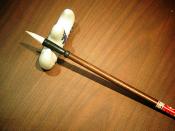For a few short years, from the beginning of the 1850s to the early 60s, thousands of people flocked to Australia. The ships that brought them often swung empty at their moorings as both crews and passengers swarmed inland toward makeshift camps. The lure was gold.
With so many immigrants from different countries assembled on the goldfields, it wasn't long until threats to social stability were magnified in the form of racism.
One of the main driving forces behind this racism was competition on the goldfields. For example, initial racism centred on gold-seekers from the United States. With their experience gained on the Californian goldfields, the Americans were active and successful in Australia, not only in finding gold but in business too. This created some unease, especially from the British who had claimed Australia as theirs. Foreigners like the Americans were constantly arriving on their land to search for gold at potential places they had not discovered themselves.
Subsequently, the British were not happy with these gold-seekers and racism based largely on fear of competition erupted.
Originally, most of the racism on the goldfields involved the British's disquiet over the presence of diggers from the United States and other foreigners as they arrived, which had their own concerns about competition. However, this changed when the Chinese arrived.
The Chinese, like so many others, came to Australia to dig for gold because there were problems in their own land. Although they only numbered about 1-3% of the Australian population, the racism that resulted towards them was quite intense.
The Chinese looked different, they dressed differently and they ate different food from the Europeans. In addition, the Chinese digger living on the goldfields was usually not a 'free' man like the European. Most of the Chinese diggers were hired workers, paying off...


